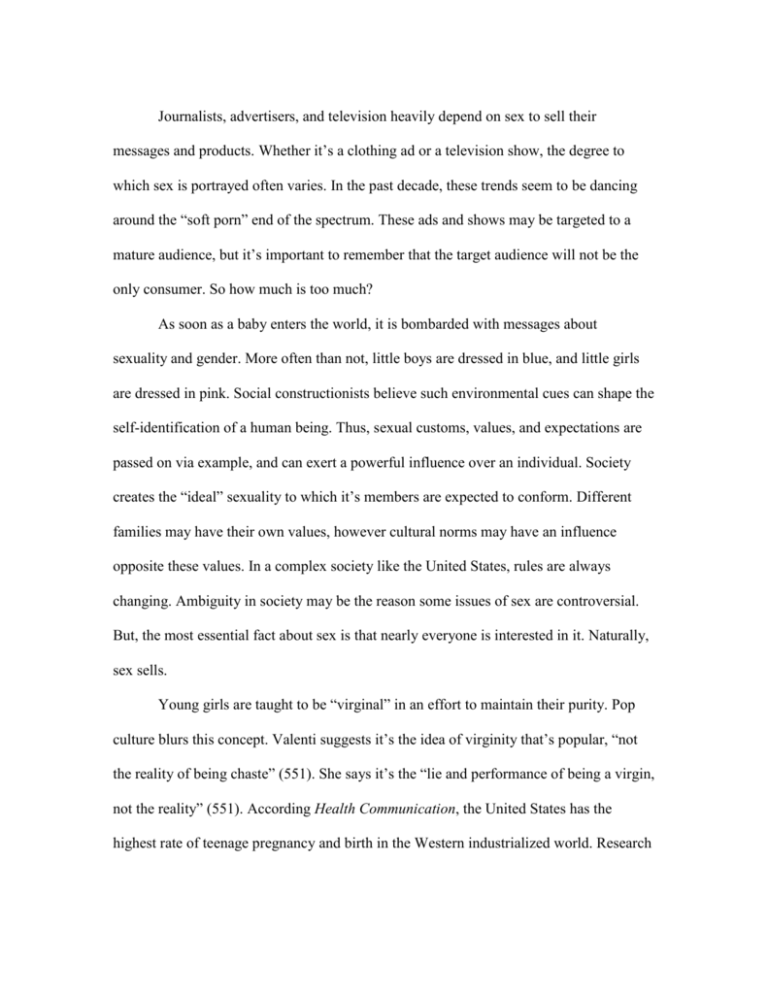
Journalists, advertisers, and television heavily depend on sex to sell their
messages and products. Whether it’s a clothing ad or a television show, the degree to
which sex is portrayed often varies. In the past decade, these trends seem to be dancing
around the “soft porn” end of the spectrum. These ads and shows may be targeted to a
mature audience, but it’s important to remember that the target audience will not be the
only consumer. So how much is too much?
As soon as a baby enters the world, it is bombarded with messages about
sexuality and gender. More often than not, little boys are dressed in blue, and little girls
are dressed in pink. Social constructionists believe such environmental cues can shape the
self-identification of a human being. Thus, sexual customs, values, and expectations are
passed on via example, and can exert a powerful influence over an individual. Society
creates the “ideal” sexuality to which it’s members are expected to conform. Different
families may have their own values, however cultural norms may have an influence
opposite these values. In a complex society like the United States, rules are always
changing. Ambiguity in society may be the reason some issues of sex are controversial.
But, the most essential fact about sex is that nearly everyone is interested in it. Naturally,
sex sells.
Young girls are taught to be “virginal” in an effort to maintain their purity. Pop
culture blurs this concept. Valenti suggests it’s the idea of virginity that’s popular, “not
the reality of being chaste” (551). She says it’s the “lie and performance of being a virgin,
not the reality” (551). According Health Communication, the United States has the
highest rate of teenage pregnancy and birth in the Western industrialized world. Research
indicates media are important sources of sexual information for young people (Austin,
462).
Advertising is frequently used as a form of communication. An extremely potent
force, especially in America, studies estimate the average consumer sees about 3,000
advertising messages in a week. Sex has become a popular persuasive tactic in
advertising. Studies indicate sexual depictions are so common that adolescents encounter
10,000 to 15,000 sexual references, jokes, or instances of nudity in the media each year.
Sexuality in an image can be portrayed in clothing, positioning, lighting, location,
interaction, the body of the model, skin, and presence. Sex sells.
Advertisers tend to target body-image-concerned teens and young adults. These
two groups comprise a large portion of American consumer spending. The UW-L Journal
of Undergraduate Research estimates teens spend about $100 billion, and parents spend
an additional $50 billion on their teens every year. The combination of advertising and
buying power allows for message interpretation. This is where the problem arises.
Sexual portrayals in the mass media provide adolescents with a plethora of often
misleading sexual depictions. These images range from kissing and flirting to explicit
portrayals of sexual intercourse. Along with these depictions and sexual stereotypes, the
media rarely provides information about sexual health, or how to positively interpret
these messages. Several studies indicate there is a strong association between sexual
media content and adolescent sexual behavior. Research also shows people consider
information from sources similar to themselves as more trustworthy and “less
threatening” (Pinkleton, 464). Thus, people are more likely to believe a source is credible
when they can identify with them. People primarily respond to messages in the same
way. These responses are comprised of logical comparisons and affective reactions. More
often than not, affective reactions overpower logical connections. Teen sexuality results
from fashion and the appearance of the teen body and its acceptance is a critical part of
teen sexual identity. Hormones drive sexual behavior and desire. When an advertisement
seems desirable for an adolescent, the message encourages them to emulate the behaviors
portrayed in a message believing these behaviors will provide personal benefits.
Statistics indicate the emulation of sexual promiscuity as viewed in the media
does not necessarily provide personal benefits. While it may provide personal pleasure
for minutes or hours, consequences can be devastating. Studies indicate that the average
American loses their virginity at the age of 16. Research also suggests that fewer than 30
percent of American teenagers graduate high school a virgin (Armstrong). Even more
disturbing, the Kaiser Family Foundation estimates about 4 million adolescents contract a
sexually transmitted disease each year. In addition, approximately one fourth of
unintended pregnancies occur in women under the age of 20. Aside from diseases and
unwanted pregnancies, other reasons encourage parents to speak out against sexual
depictions in the media. Parents and psychologists argue sending the message about
having sex too early can encourage adolescents to seek sex for the wrong reasons.
Ultimately, it could also have an impact on their ability to sustain healthy future
relationships. Jane Brown of the University of North Carolina did a study which suggests
that adolescents consuming a media diet rich in sexual content were more than twice as
likely as others to have had sex by age 16 (Luscombe, 2).
Clothing company, Abercrombie and Fitch, thrives on risqué, sexy advertisements
to sell their products. In the late 1990s, Abercrombie and Fitch became financially stable
as their own company. They launched a new advertising campaign by creating their own
magazine, The A&F Quarterly. Before the catalog, Abercrombie and Fitch produced
about 85 million dollars in revenue. After launching their new, sexy catalog, the company
added 455 stores to their previous 36, bringing in a revenue of 1.35 billion dollars. In
1998, Abercrombie and Fitch issued over 1.5 million catalogs.
In December of 2003, Abercrombie and Fitch pulled their main form of
advertising after controversy of their risqué catalog arose. The holiday of the A&F
Quarterly was scrutinized for using nude young adult models posed in suggestive ways.
The catalog also contained a series of sex-related discussion articles. It featured a Q and
A with Sari Locker encouraging teens to be “focused on getting experience” rather than
looking for someone to marry. Other discussion articles included topics such as group sex
and group masturbation (Chittenden, 84). The main argument seemed to be the age group
modeling and consuming the images. Critics also lashed out against the articles in the
magazines focused their topics on sex. The company argues these articles were intended
to boost sales among the clothing retailer’s college-age customers. In fact, Abercrombie
and Fitch headquarters is set up as a college campus to keep executives focused on their
target group. Those disturbed by the content argued while the traditional customer may
be college age, the book may fall into the hands of others who are not. Little brothers and
sisters idolizing their older sibling may gain access to the catalog. Not mature enough to
interpret these messages in a healthy way, things may go wrong.
Actual advertising of clothing and Abercrombie products didn’t begin until page
120 of the 280-page catalog. The company sold over 200,000 copies of the issue before
pulling it from the shelves. Although Abercrombie and Fitch discontinued the use of their
catalog as an advertising mechanism, they’ve found plenty of ways to continue selling
their lifestyle while using sex appeal.
Image building begins at the center of operation. The company, based in New
Albany, Ohio, spent 130 million dollars to model their headquarters after a college
campus. The purpose of this was to ensure creators stayed focused on the target
audience—college students. The campus is complete with fireplaces, techno music, a
bonfire pit, the gym, cafeteria, desks, library carrels, and chalkboards throughout the
buildings. They even had a keg party to mark the grand opening. While it represents the
college way, is this a responsible way to portray the company?
The company further promotes this “lifestyle” by the interior decorating of the
stores. Stores are primarily Victorian style with large leather couches. Incorporated
throughout are large posters of half-naked models in flirtatious and sometimes suggestive
poses. Some images don’t even show the face of the model. Some just show a male
model’s six pack or the muscular legs of a female body.
Employees further promote the “lifestyle.” Abercrombie tends to hire “young,
attractive, and Caucasian” employees. This brings up two issues. First, the target
audience will not be the only one to see these images. Second, if Abercrombie and Fitch
only hires Caucasian employees and models, there is an issue of discrimination.
In 2005, Abercrombie acquired more scrutiny. This time, the company faced
discrimination charges. On April 14, 2005, a California U.S. District Court ruled in favor
of Gonzalez. Abercrombie and Fitch had to pay 50 million dollars to Latino, African
American, and female applicants and employees who charged the company with
discrimination. The retailer has managed to fix issues of discrimination. They have begun
hiring employees and models of all races and ethnic backgrounds, however, one still
finds employees and models are usually thin and in-shape.
The company may have addressed their discrimination flaws, but they still firmly
believe sex sells. That’s because it does. Everything from the images on the bags they use
to the images on their giftcards are risqué. They all suggest a luxurious lifestyle of sexual
promiscuity with everything to gain and nothing to lose. The primary target group may be
college students, but they aren’t the only one seeing these images and interpreting these
messages.
As an advertiser, I think it would be hard to be completely ethical and still
promote the Abercrombie lifestyle. As a journalist I would impose Utilitarianism when
trying to construct an advertising campaign. This means I would try and execute a
campaign that imposed the greatest good for the greatest number of people. The company
can still cater to the elite and promote their lifestyle even if their model had on more
clothes. Isn’t the point the sell clothing? How can you sell your clothing if you use a
model with no clothes? It just doesn’t make sense. I would little things to change the
campaign that would make it more suitable for everyone. I would add a few more clothes
to the model. They certainly wouldn’t be nude. A person fully clothed in Abercrombie
and Fitch clothing is revealing enough. Therefore, removing additional clothing is not
necessary. Small adjustments such as changing the poses of the models to be less
suggestive can decrease controversy.
As a journalist, I think you also have to look at it from a Communitarian point of
view. If the advertisement is suggesting promiscuity is the answer for teens, that’s not
exactly “building a better world for tomorrow.” Obvious statistics back that up. As an
advertiser, I think you have to ask yourself, “If I was a parent how would I react if my
adolescent saw this ad?” Another question I would ask myself is, “What message is this
advertisement sending?”
In 2010, Abercrombie and Fitch reinstated the production of the A&F Quarterly.
The magazine still depicts half-naked models in risqué poses. Abercrombie and Fitch
targets and caters to a specific audience. This audience is brand loyal regardless of the
advertising mechanisms. They’re not looking to accommodate everyone. They’re not
necessarily going to lose business, and they know it. They have a firm consumer base
which isn’t going anywhere because of a half-naked guy with good abs. They’re an
institution that thrives on controversy.
The company no longer sends out catalogs but requires a subscription from an
adult over the age of 18. Consumers must also pay $10 if they wish to obtain a copy.
Before, the magazine was free. This still doesn’t ensure that adolescents won’t see a copy
of the magazine. Ultimately, it’s up to parents to educate their children on sexual
behavior and media literacy. Parents begin teaching their children sexuality and gender
from birth, subconsciously or not. It’s their duty to continue guiding them along a
healthy. Sex sells, and advertisers capitalize on this. In today’s society almost anything
goes. The key to keeping things from blossoming out of control is education.
Advertisers aren’t the only ones who use sex to promote products and ideas.
Adolescents are impressionable, and have a strong desire to fit in. They are affected by
peer pressure and the need to conform. This makes them socially vulnerable, thus, they
simply emulate what they see and envy what is popular. It’s human nature. The approach
“sex sells” may fail teens in our responsibility as a society to educate them about
sexuality and desire. By just promoting images without explanation, teens are left to their
own interpretation. A male and female placed in suggestive poses is easily interpreted.
Not only will adolescents form their own opinions, but they will adopt those of their
peers as well. If we raised our children in an environment that encouraged healthy sexual
behavior, we may not see some of these things as issues. If children were more educated
and raised to sexual behavior as a healthy natural desire rather than a stigmatism, they
may be in a better position to make better judgments of advertisements containing sexual
images.
Abercrombie and Fitch is neither the only company, nor the last company that
will use risqué images to promote their product or idea. Reichert reports that magazines
aimed at young adults were 65 percent more likely to contain provocatively dressed
models and 12 percent more likely to contain sexual behavior than those aimed at mature
readers (Chittenden, 80). Shouldn’t this be the other way around?
Regardless, sexual desires and behaviors of adolescents are not solely the product
of media representation. While these media depictions may have significant influence
over a teen’s opinions, young people will inevitably behave how they wish. Sexual
behavior is a natural occurrence that teens will engage in when they deem fit regardless
of messages sent by parents, media, or peers. They may be impressionable, but they’re
still capable of making their own decisions.
Journalists and advertisers need to be aware what their message is saying. Yes,
sex sells, but we have a responsibility to the public to portray our message ethically, and
in the best way possible for the entire community. Using soft porn examples to promote
our messages is not exactly the greatest good for the greatest number of people. While
parents must monitor what their kids are viewing and consuming, parents can’t be around
all the time, and journalists should not make their job harder by allowing these types of
messages to slip through the cracks.
Works Cited
Austin, Erica Weintraub and Bruce E. Pinkleton. “Effects of a Peer-Led Media Literary
Curriculum on Adolescent’s Knowledge and Attitudes Toward Sexual Behavior
and Media Portrayals of Sex.” Health Communication. 23:5 (2008): 462-472.
Chittenden, Tara. “For whose eyes only? The Gatekeeping of Sexual Images in the Field
of Teen Sexuality.” Sex Education. 10:1 (2010): 79-90.
Driessen, Claire E. “Message Communication in Advertising: Selling the Abercrombie
and Fitch Image.” UW-L Journal of Undergraduate Research VII (2005): 1-12
Luscombe, Belinda, Kathleen Kingsbury, Elisabeth Salemme, Tiffany Sharples. “The
Truth About Teen girls.” Time. 172:12 (2008): 64-69.
Rutter, Virginia and Pepper Schwartz. “Sexual Desire and Gender.” Women’s Voices,
Feminists Visions. Michael Ryan. New York, NY: McGraw-Hill, 2009.
Valenti, Jessica. “Pop Culture Gone Wild.” Women’s Voices, Feminists Visions. Michael
Ryan. New York, NY: McGraw-Hill, 2009.
Williams, Armstrong. “Teen Sex: There Are No Positives.” New York Amsterdam News.
98:51 (2007): 13.








